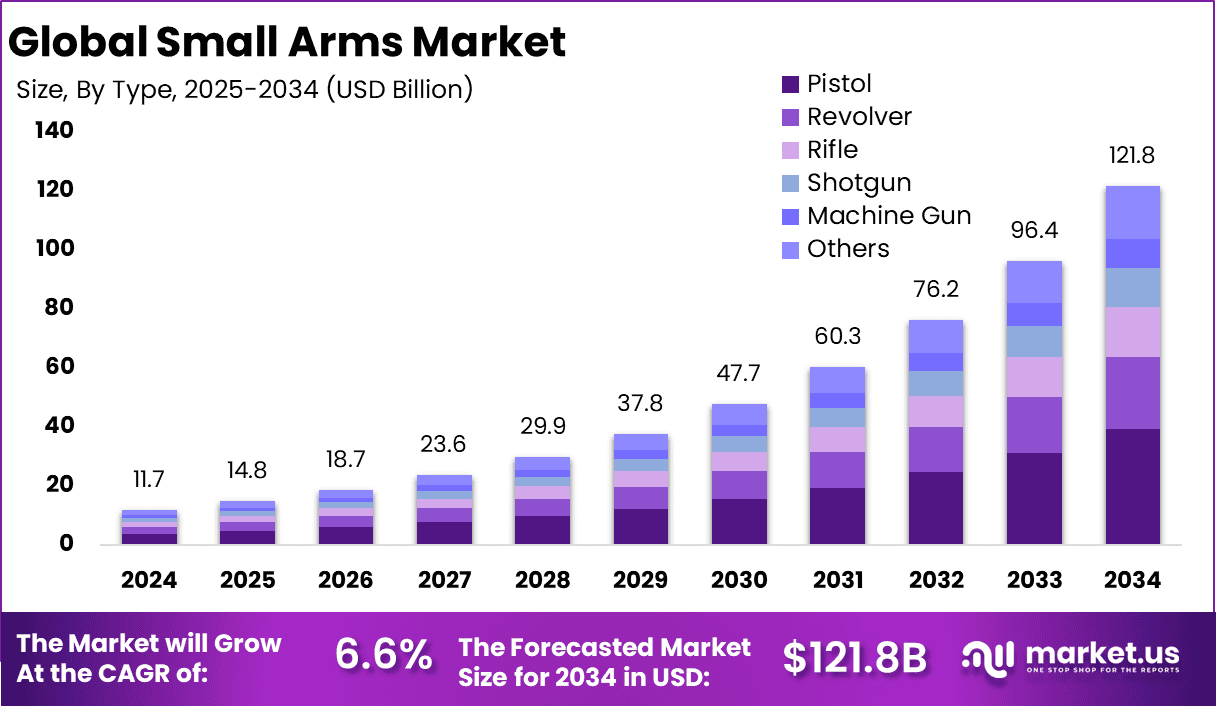Table of Contents
Introduction
The global small arms market is projected to grow from USD 11.7 billion in 2024 to USD 121.8 billion by 2034, registering a CAGR of 6.6%. In 2024, North America dominated with a 38.2% market share, generating USD 4.4 billion in revenue. The growth is driven by increasing defense spending, rising security concerns, and the modernization of military and law enforcement agencies. Technological advancements in small arms, along with growing demand for lightweight and efficient weapons, are further fueling market expansion globally.

How Tariffs Are Impacting the Economy
Tariffs on small arms components and manufacturing equipment increase production costs, leading to higher prices for governments and private buyers. Elevated tariffs contribute to inflationary pressures, which can limit defense budgets and slow procurement cycles.
➤ Discover how our research uncovers business opportunities @ https://market.us/report/global-small-arms-market/free-sample/
(Use corporate mail ID for quicker response)
Supply chain disruptions caused by tariffs force manufacturers to seek alternative suppliers or relocate production, often incurring higher operational expenses and longer lead times. Retaliatory tariffs escalate geopolitical tensions, creating uncertainty that hinders international defense collaborations and arms trade. These factors collectively affect investments in modernization and innovation within the small arms sector, potentially impacting national security and defense readiness.

Impact on Global Businesses
Small arms manufacturers face increased costs due to tariffs on raw materials, electronics, and precision components. Supply chain realignment to mitigate tariffs adds complexity and capital expenditure. Defense contractors and security agencies experience delays in acquiring modern weaponry, affecting operational capabilities. Emerging markets reliant on imports face higher prices and restricted access. These challenges compel firms to optimize manufacturing processes, diversify suppliers, and invest in localized production. Sector-specific impacts include regulatory compliance costs and fluctuating demand tied to geopolitical developments. Innovation and agility remain critical to navigating tariff-driven pressures.
Strategies for Businesses
Companies diversify supply chains and invest in regional manufacturing to reduce tariff exposure. Adoption of modular weapon designs lowers production costs and facilitates customization. Leveraging predictive analytics helps anticipate tariff changes and optimize inventory management. Strategic partnerships with local governments and defense firms enhance market access. Digital transformation, including automation and advanced manufacturing techniques, improves efficiency and cost-effectiveness. Advocacy and engagement with policymakers aim to influence favorable trade policies. Overall, innovation, supply chain resilience, and strategic collaboration are essential for sustained growth.
➤ Get full PDF access here @ https://market.us/purchase-report/?report_id=148880
Key Takeaways
- Small arms market expected to grow at 6.6% CAGR through 2034
- Tariffs increase production costs and disrupt global supply chains
- Defense procurement delays impact modernization and readiness
- Supply diversification and modular designs mitigate tariff effects
- Predictive analytics supports proactive risk management
Analyst Viewpoint
The small arms market exhibits steady growth driven by rising defense expenditures and security challenges worldwide. While tariffs introduce cost pressures and supply uncertainties, they also incentivize innovation and localization of production. Market leaders focus on modular technologies and strategic partnerships to maintain competitiveness. The outlook remains positive as geopolitical tensions sustain demand and technological advancements enhance product offerings. Regional investments and evolving defense strategies will continue to drive market expansion.
Regional Analysis
North America dominates the small arms market with a 38.2% share in 2024, led by the U.S., driven by substantial defense budgets and advanced manufacturing capabilities. Europe follows with steady growth fueled by modernization programs and export activities. Asia-Pacific shows emerging potential due to increasing security concerns and military modernization efforts. Regional disparities arise from varying defense policies, geopolitical dynamics, and industrial capacities, influencing market development globally.
➤ Discover More Trending Research
Business Opportunities
Opportunities exist in developing lightweight, modular, and smart small arms tailored to diverse operational needs. Growth in emerging markets offers potential through modernization and border security investments. Integration of AI and IoT enhances weapon functionality and battlefield awareness. Collaborations with defense agencies accelerate innovation and market penetration. Additionally, aftermarket services, training, and maintenance represent expanding revenue streams. Sustainable manufacturing and export compliance also present competitive advantages.
Key Segmentation
Weapon Type
- Handguns
- Rifles
- Submachine Guns
- Machine Guns
End User
- Military
- Law Enforcement
- Civilian
Region
- North America
- Europe
- Asia-Pacific
- Middle East & Africa
- Latin America
Key Player Analysis
Market leaders invest heavily in R&D to enhance weapon precision, reliability, and modularity. Emphasis on compliance with international arms regulations is critical. Strategic alliances with governments and defense contractors expand product reach. Companies focus on integrating smart technologies and lightweight materials. Expansion into emerging markets through localized production and partnerships supports growth. Customer-centric innovation and robust service networks sustain competitive positioning.
Top Key Players Covered
- Colt’s Manufacturing LLC
- Sig Sauer
- Steyr Arms
- Remington Outdoor Company
- Smith & Wesson
- Daniel Defense Inc.
- Sturm, Ruger & Co., Inc.
- Israel Weapons Industry
- GLOCK Ges.m.b.H.
- Kalashnikov Group
- Èeská Zbrojovka a.s.
- Others
Recent Developments
In 2025, key manufacturers unveiled advanced modular rifles with AI-enabled targeting systems. Strategic collaborations with defense ministries accelerated modernization projects. Increased focus on sustainable manufacturing processes emerged.
Conclusion
The small arms market is set for consistent growth, driven by defense modernization and security concerns. Tariff challenges prompt innovation and supply chain resilience. Continued investment in technology and regional expansion will underpin future market success.
Discuss your needs with our analyst
Please share your requirements with more details so our analyst can check if they can solve your problem(s)



